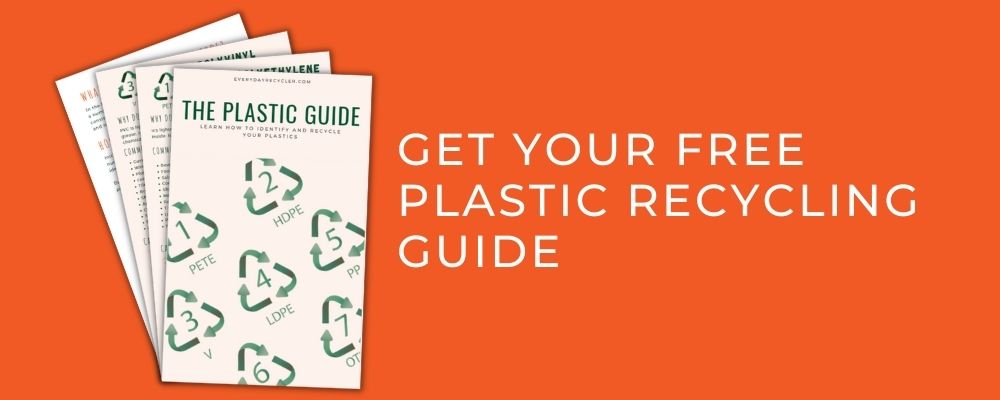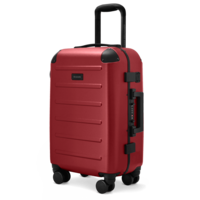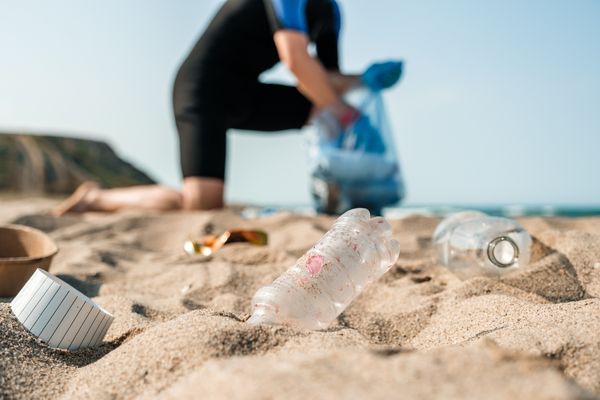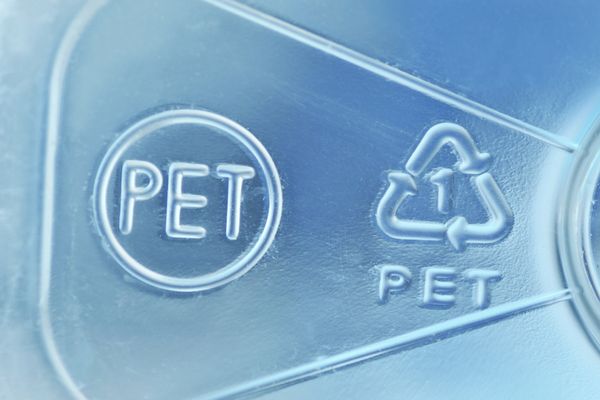Polyethylene terephthalate or PET (also abbreviated to PETE sometimes) is the most commonly produced plastic. You might recognize it as plastic number #1 in the plastic resin code, a number 1 in the chasing arrows. PET is a polyester thermoplastic. It was invented in 1940 by chemists at the DuPont company and is made by polymerization of ethylene glycol and terephthalic acid.
Learn more in What is Plastic.
Quick Navigation
What is PET?
Polyethylene terephthalate has many properties that make it an extremely useful material. It is ubiquitous in our day-to-day lives. You will likely have already been in contact with PET plastic many times during your day.
The first picture that comes to mind when you mention PET is a plastic water bottle; however, interestingly, most PET in the world is found in clothing. The fabric referred to as polyester is the same stuff that goes into plastic bottles.
The difference between the two items is the way the polyethylene terephthalate is prepared. To make bottles or other rigid containers, the plastic is heated and then injected into bottle-shaped molds. In contrast, polyester fibers are made by melting plastic and forcing it through tiny holes to produce the fibers.

Why do we use it?
Polyethylene terephthalate or PET is common for good reason. It is a highly versatile material, and it’s lightweight, safe, and easy to recycle. The properties that manufacturers love about PET are:
- Buffington, Jack. (2018), Peak Plastic: The Rise or Fall of Our Synthetic World, ABC-CLIO
- Freinkel, Susan. (2011), Plastic, A Toxic Love Story, Melbourne Australia, The Text Publishing Company
- Sustainability
- Sustainability & Recyclability, PET Resin Association
- 2016, Everything you Need to Know About The World’s Most Useful Plastic (PET and Polyester), Creative Mechanisms
- Polyester, How Products Are Made
- Suez, 2009, PET ‘bottle to bottle’ recycling unit, sustainabilitymatters.net.au
- William Harris, How long does it take for plastics to biodegrade?, howstuffworks.com
- 2019, At Limay in France, SUEZ manufactures plastic food packaging from recycled PET plastics, Suez
- Textiles
- Fleece jackets
- Carpets
- Stuffing
- Storage containers
- Boat sails
- Shoes
- Auto parts
Great products made from Recycling PET
There are new products popping up all the time. Check out 8 great products made from recycled ocean plastic.
You can find many brands that use recycled PET and other recycled materials in our BRAND DIRECTORY. I have listed some of our favorite recycled PET items below.
Solgaard
Solgaard has partnered with The Plastic Bank to help tackle ocean pollution. For every purchase Plastic Bank will clean plastic from the ocean and upcycle it into useful products. Creating local jobs for the teams in the Phillippines and reducing plastic pollution.
Solgaard design their luggage with sustainability in mind. However, their designs have some other pretty cool features. They have solar panels on their backpacks and USB charging ports in their luggage and even secret compartments for your passports and cards.


Tentree
Tentree makes earth-first essentials made from organic and recycled materials including recycled polyester, as well as Tencel, hemp, and organic cotton. Their products range from loungewear to activewear for women, men, and your little ones. Think hoodies, casual pants, t-shirts, and stylish jumpsuits.

The sustainable no fuss jumpsuit.

What happens when PET is not recycled?
Certain types of bacteria have been discovered that will break down plastic and research is ongoing as to how we might use these. Still, the best thing is to recycle the plastic so that we can get more use out of the material after making the effort and using the energy to extract it from the earth.

Summary
PET is the most common plastic because its properties make it an extremely useful material. PET is also very recyclable. It is almost certain that if you have a curbside recycling program that it will include plastic number #1, PET. So, make sure you recycle all your PET plastics, it’s easy.
- Look for the number 1 in the chasing arrows symbol to identify your number one plastics.
- Be sure to clean out any food from your containers and place them in your recycling bin.
- Keep clothing and other unusual items such as carpet and ropes out of your curbside pickup.
- If you do not have a curbside recycling program then see if you have access to a container deposit depot.
Reduce, reuse and then recycle, recycle, recycle your PET. 😊
If you want to know about the other Plastic recycling codes check out these articles :
- Buffington, Jack. (2018), Peak Plastic: The Rise or Fall of Our Synthetic World, ABC-CLIO
- Freinkel, Susan. (2011), Plastic, A Toxic Love Story, Melbourne Australia, The Text Publishing Company
- Sustainability
- Sustainability & Recyclability, PET Resin Association
- 2016, Everything you Need to Know About The World’s Most Useful Plastic (PET and Polyester), Creative Mechanisms
- Polyester, How Products Are Made
- Suez, 2009, PET ‘bottle to bottle’ recycling unit, sustainabilitymatters.net.au
- William Harris, How long does it take for plastics to biodegrade?, howstuffworks.com
- 2019, At Limay in France, SUEZ manufactures plastic food packaging from recycled PET plastics, Suez














